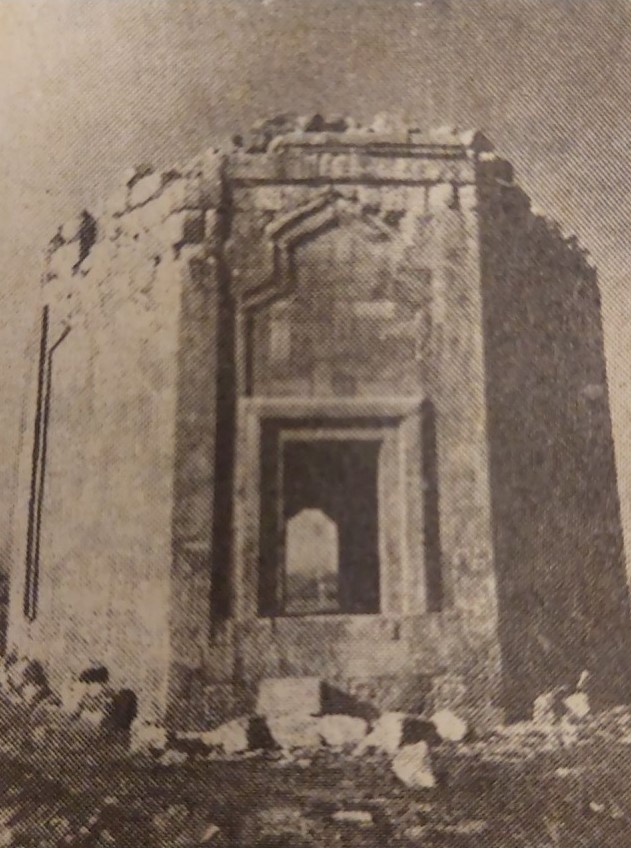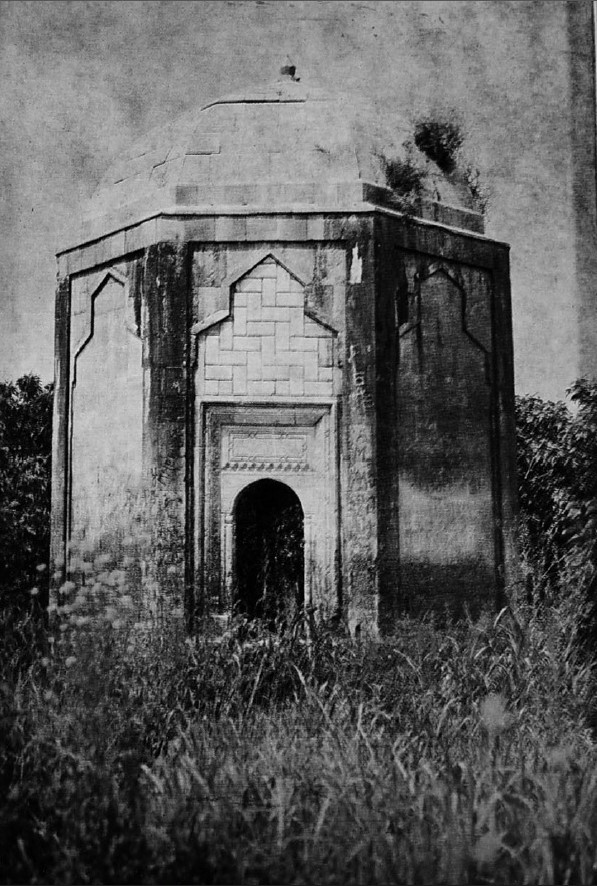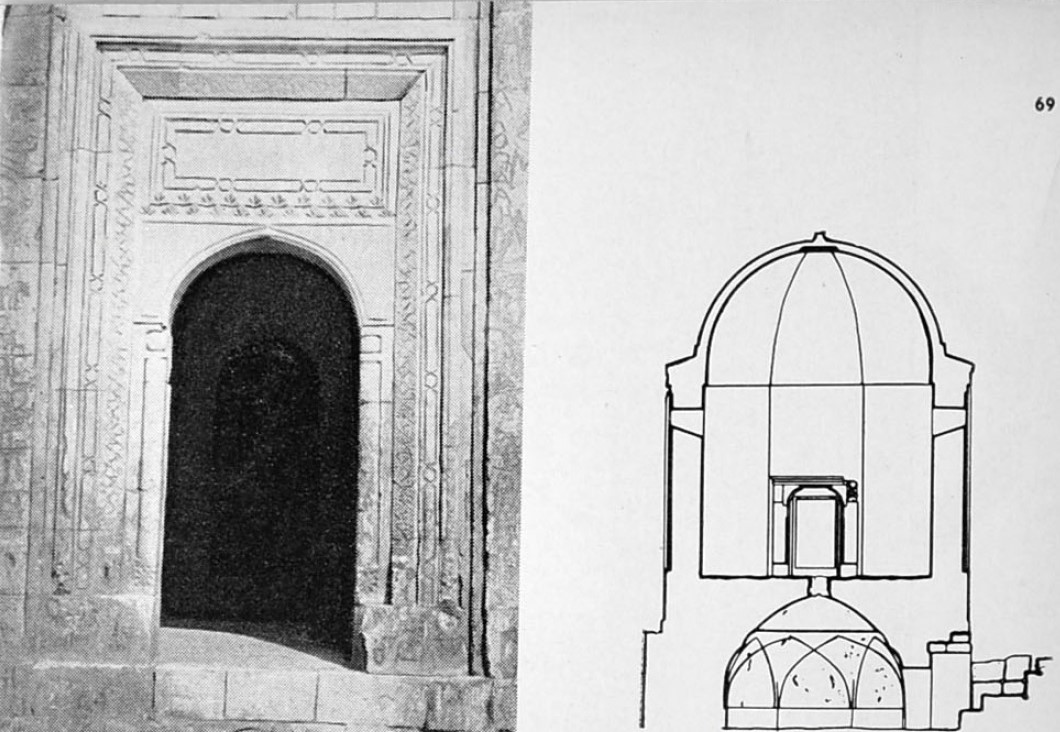Ahmadalilar mausoleum (in some sources it is called Argali tomb) is located on the left bank of Araz river, in Ahmadalilar village of Fuzuli region.
[A.V. Salamzadeh, K. M. Mammadzadeh. Monuments on Araz. 1979, p. 57]
[G. Mammadova, Z. Mammadova. Architecture of the Middle Ages (8th-14th centuries) Second volume. 2013, p. 191]
It is believed that the mausoleum was built in the 13th-14th centuries (or the end of the 13th century – the beginning of the 14th century).
[A.V. Salamzadeh, K. M. Mammadzadeh. Monuments on Araz. 1979, p. 58]
[К. M. Mammadzadeh. Construction art of Azerbaijan (from ancient times to the 19th century) 1983, p. 42]
[G. Mammadova, Z. Mammadova. Architecture of the Middle Ages (8th-14th centuries) Second volume. 2013, p. 191]
[A short art encyclopedia. Art of countries and peoples of the world. Volume 1. 1962, p. 52]

The mausoleum has an octagonal shape and is covered with a cloistered octagonal cupola. It was built of stones. The cupola of the mausoleum is double, its construction consists of two rows of stones filled in between. The interior of the monument consists of a burial vault and a spacious upper cell. There is no mihrab-portico inside the mausoleum. The mausoleum has two entrances, oriented to the north and south, and designed in the form of smooth portals-niche. The portal framing of the entrances of the monument is filled with carved patterns of various geometric designs on the southern and northern portals. From this point of view, the influence of the Nakhchivan School of architecture can be observed.
[G. Mammadova, Z. Mammadova. Architecture of the Middle Ages (8th-14th centuries) Second volume. 2013, p. 191]
[К. M. Mammadzadeh. Construction art of Azerbaijan (from ancient times to the 19th century) 1983, p. 42]
[A.V. Salamzadeh, K. M. Mammadzadeh. Monuments on Araz. 1979, p. 57-58]
[A short art encyclopedia. Art of countries and peoples of the world. Volume 1. 1962, p. 52]
[Azerbaijan soviet encyclopedia. Volume 4. 1980, p. 257]
There is no figured masonry on the exterior of the Ahmadalilar Mausoleum. No inscriptions have been preserved on the mausoleum and there is no information about their existence. The monument is closer to the usual octagonal mausoleums of Azerbaijan, mainly in dome shape. The Azerbaijani art critic Abdulvahab Salamzadeh attributed the mausoleum to “towerless octagonal mausoleums”.
[К. M. Mammadzadeh. Construction art of Azerbaijan (from ancient times until the 19th century) 1983, p. 42]
[M. Useynov. L. Bretanitskiy. A. Salamzadeh. Architectural history of Azerbaijan. 1963, p. 101]

In 1946, the mausoleum was investigated by the expedition of the Azerbaijan Art Institute of the Academy of Sciences of the Azerbaijan SSR. The mausoleum, which was destroyed in the 1960s, was restored to its original appearance. A. V. Salamzadeh, K. M. Mammadzadeh’s 1979 book “Monuments on Araz” states the following:
“Unfortunately, we are witnessing this mausoleum in a very bad condition, and the destruction itself affected the most interesting parts of the monument – the sides of the northern and southern portals. From the north side, the ruin has the appearance of a whole hole covering the north portal and its neighboring northeast sides. According to local residents, these ruins were the result of an earthquake that occurred here in 1929. Fallen stones are all around the monument. As a result of excavations and research of the monument in the 1940s and later in the 1950s, significant material was collected, which allowed the restoration of the entire mausoleum and portal framing to original appearance, as well as in-kind restoration works”.
[Azerbaijan soviet encyclopedia. Volume 4. 1980, p. 257]
[A.V. Salamzadeh, K. M. Mammadzadeh. Monuments on Araz. 1979, p. 57]
[“Azerbaijani architecture. Nizami Ganjavi`s period. 1947, p. 165]

The monument is identical to the nearby mausoleum in the village of Babı (Sheykh Babı Yagub Mausoleum), except for a number of architectural features. There is a legend among the local population that there is an underground passage between the Ahmadalilar Mausoleum and the latter:
“The best craftsman of that time was invited to build the mausoleum. This craftsman built this mausoleum with his disciple who traveled to the village of Ahmadalilar, which is 9 km away from the village of Babı, passing through an underground passage dug secretly from him, and built a similar mausoleum there. The student repeated all the techniques and characteristic features of his teacher. When the craftsman finished his mausoleum, the mausoleum in Ahmadalilar village was also completed at the same time which amazed the master that the student surpassed his teacher.”
[Azerbaijani architecture. Nizami Ganjavi`s period. 1947, p. 165]
[A.V. Salamzadeh, K. M. Mammadzadeh. Monuments on Araz. 1979, p. 57]
[A short art encyclopedia. Art of countries and peoples of the world. Volume 1. 1962, p. 52]




